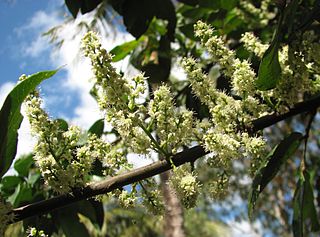
Castanopsis cuspidata is a species of Castanopsis native to southern Japan and southern Korea.

Guioa is a genus of about 78 rainforest tree species known to science, which constitute part of the plant family Sapindaceae. They have a wide distribution, ranging from throughout Malesia, in Burma, Cambodia, Vietnam, Thailand, Malay Peninsula, Borneo, Sumatra, Philippines, Java, Flores, Timor, Sulawesi, Moluccas, New Guinea, further southwards through the east coast of Queensland and New South Wales, Australia and further eastwards to the Pacific Islands, including Tonga, New Caledonia, Fiji and Samoa.

A genet is a member of the genus Genetta, which consists of 14 to 17 species of small African carnivorans. The common genet is the only genet present in Europe and occurs in the Iberian Peninsula, Italy and France.
This article is a list of biological species, subspecies, and evolutionary significant units that are known to have become extinct during the Holocene, the current geologic epoch, ordered by their known or approximate date of disappearance from oldest to most recent.

Carpoxylon macrospermum is a species of palm tree endemic to Vanuatu, and the only species in the genus Carpoxylon.

Archidendron bigeminum is a tree species in the legume family (Fabaceae). It is found in India and Sri Lanka. It is known as "Kalitiya - කලටිය" in Sinhala people.
Castanopsis catappaefolia is a species of plant in the family Fagaceae. It is a tree endemic to Peninsular Malaysia. It is threatened by habitat loss.
Castanopsis concinna is a species of plant in the family Fagaceae. It is a tree found in broad-leaved evergreen forests of southern Guangdong and Guangxi in China and in Hong Kong. It is under second-class national protection in China. It is threatened by habitat loss.
Castanopsis curtisii is a species of plant in the family Fagaceae. It is a tree endemic to Peninsular Malaysia. It is threatened by habitat loss.
Castanopsis kawakamii is a species of plant in the family Fagaceae. It is found in China, Taiwan, and Vietnam. It is threatened by habitat loss.
Castanopsis scortechinii is a species of plant in the family Fagaceae. It is a tree endemic to Peninsular Malaysia. It is threatened by habitat loss.
Castanopsis wallichii is a species of plant in the family Fagaceae. It is a tree found in Peninsular Malaysia and Singapore. It is threatened by habitat loss.

Helicia is a genus of 110 species of trees and shrubs, constituting part of the plant family Proteaceae. They grow naturally in rainforests throughout tropical South and Southeast Asia, including India, Sri Lanka, Indochina, Peninsular Malaysia to New Guinea and as far south as New South Wales.

Leucadendron discolor is a species of plant in the family Proteaceae. It is endemic to South Africa. It is threatened by habitat loss. In English the plant is known as the Piketberg Conebush and in Afrikaans as the Rooitolbos. L. discolor is a slow growing perennial. Growth of the root system and propagation, from a seed to the plant's first flower, can take up to two years. The male L. discolor 'Sunset' flowers exuberantly during early spring exposing a colorful flowerhead during this time.The flower head is composed of a dome-like receptacle, and is densely covered with small male flowers. These plants are only able to reproduce after their third year of life.
Castanopsis javanica, the Javan chestnut-oak, is a tree in the beech family Fagaceae. The specific epithet javanica is from the Latin, meaning "of Java".

Castanopsis argentea is an evergreen tree native to Indonesia, where it is known as sarangan. It is mostly found in undisturbed forests of West Java around Mount Gede and Mount Halimun, with a density of ca. 12 trees/hectare. It also occurs in national parks, nature reserves and at high altitude forests in other areas of Java. It is almost extinct from lowland areas in Sumatra, due to the clearance of the land for palm oil plantations.
Tetratheca nephelioides is a species of plant in the quandong family that is endemic to Australia.








